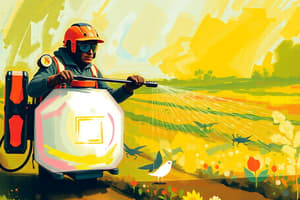Podcast
Questions and Answers
Which pesticide application method involves mixing pesticides with an equal quantity of sand before application?
Which pesticide application method involves mixing pesticides with an equal quantity of sand before application?
- Broadcasting (correct)
- Root zone application
- In furrow application
- Spot application
For controlling sorghum shoot fly with seed pelleting, which insecticide and application rate is appropriate?
For controlling sorghum shoot fly with seed pelleting, which insecticide and application rate is appropriate?
- Carbofuran 3 G at 3 g per meter row
- Carbofuran 50 SP as a foliar spray
- Chlorpyriphos at 4 ml/kg of seed (correct)
- Malathion at 0.05% for 15 minutes
What is the primary purpose of 'pralinage' in banana cultivation?
What is the primary purpose of 'pralinage' in banana cultivation?
- To protect against termites
- To treat fungal infections
- To control burrowing nematode (correct)
- To control banana aphid
What is the purpose of treating sugarcane setts with Imidacloprid?
What is the purpose of treating sugarcane setts with Imidacloprid?
In trunk/stem injection for coconut trees, what is typically injected into the tree?
In trunk/stem injection for coconut trees, what is typically injected into the tree?
Which application method involves removing bark and placing insecticide-soaked cotton on the exposed area?
Which application method involves removing bark and placing insecticide-soaked cotton on the exposed area?
What is the key principle behind the baiting method of pesticide application?
What is the key principle behind the baiting method of pesticide application?
Which of the following methods is most suitable for controlling red palm weevil in coconut trees via trunk application?
Which of the following methods is most suitable for controlling red palm weevil in coconut trees via trunk application?
When applying granules in furrow, what is typically done after placing the granules?
When applying granules in furrow, what is typically done after placing the granules?
What is the primary advantage of granular application of pesticides?
What is the primary advantage of granular application of pesticides?
Which type of spraying covers the largest area per day?
Which type of spraying covers the largest area per day?
What equipment is typically used for high volume spraying?
What equipment is typically used for high volume spraying?
What is a typical method for controlling coffee white borer?
What is a typical method for controlling coffee white borer?
In root feeding, how is the insecticide typically introduced to the plant's root system?
In root feeding, how is the insecticide typically introduced to the plant's root system?
Which fumigant is recommended for controlling stored product pests in godowns?
Which fumigant is recommended for controlling stored product pests in godowns?
What is the purpose of 'seedling root dip' in rice cultivation?
What is the purpose of 'seedling root dip' in rice cultivation?
What is the typical application rate of Carbofuran 3 G in rice nursery broadcasting, as mentioned?
What is the typical application rate of Carbofuran 3 G in rice nursery broadcasting, as mentioned?
For spot application, where are granules typically applied?
For spot application, where are granules typically applied?
How is the insecticide applied in 'leaf whorl application'?
How is the insecticide applied in 'leaf whorl application'?
What is the purpose of drenching soil with a diluted chemical solution?
What is the purpose of drenching soil with a diluted chemical solution?
Flashcards
Dusting
Dusting
Applying pesticides as a dry powder.
Spraying
Spraying
Mixing pesticides with water and spraying.
Broadcasting (granules)
Broadcasting (granules)
Mixing granules with sand and spreading evenly.
In furrow application
In furrow application
Signup and view all the flashcards
Side dressing
Side dressing
Signup and view all the flashcards
Spot application
Spot application
Signup and view all the flashcards
Ring application
Ring application
Signup and view all the flashcards
Root Zone Application
Root Zone Application
Signup and view all the flashcards
Leaf Whorl Application
Leaf Whorl Application
Signup and view all the flashcards
Pralinage
Pralinage
Signup and view all the flashcards
Seed pelleting/seed dressing
Seed pelleting/seed dressing
Signup and view all the flashcards
Seedling Root Dip
Seedling Root Dip
Signup and view all the flashcards
Sett Treatment
Sett Treatment
Signup and view all the flashcards
Trunk/Stem Injection
Trunk/Stem Injection
Signup and view all the flashcards
Padding
Padding
Signup and view all the flashcards
Swabbing
Swabbing
Signup and view all the flashcards
Root Feeding
Root Feeding
Signup and view all the flashcards
Soil Drenching
Soil Drenching
Signup and view all the flashcards
Capsule Placement
Capsule Placement
Signup and view all the flashcards
Baiting
Baiting
Signup and view all the flashcards
Study Notes
Pesticide Application Methods
- Desired effect of a pesticide relies on appropriate methods and timing
- Application method depends on the pesticides, their form, target pests, location, and water availability
Dusting
- Carried out in the morning with light airflow, either manually or using duster
- Can be applied to soil to control soil insects
- Cost-effective for dry land crop pest control
Spraying
- Typically involves mixing EC or WP formulations with water
- Three types of spraying exist
High Volume Spraying
- Uses 200-400 liters of spray fluid per acre, covering 2.5 acres per day
- Uses knapsack and rocker sprayers
Low Volume Spraying
- Uses 40-60 liters of spray fluid per acre, covering 5.6 acres per day
- Uses power sprayers and mist blowers
Ultra Low Volume Spraying
- Uses 2-4 liters of spray fluid per acre, covering 20 acres per day
- Uses ULV and electrodyn sprayers
Granular Application
- Safely handles highly toxic pesticides
- Granules can be applied directly to the soil or plant parts
Broadcasting
- Granules mixed with equal sand quantity, spread on soil or standing water film
- Carbofuran 3 G is applied at 33 kg/ha in rice nurseries within a water film and water impounded for 3 days
In Furrow Application
- Granules applied during sowing in furrows, covered with soil before irrigation
- Carbofuran 3 G is applied at 3 g per meter row to combat sorghum shoot fly
Side Dressing
- Granules applied slightly away (10-15 cm) from established plants in a furrow
Spot Application
- Granules applied 5 cm away and deep on plant sides to reduce insecticide quantity
Ring Application
- Granules applied in a ring around trees
Root Zone Application
- Granules encapsulated and placed in the root zone of plants
- Carbofuran in rice is an example
Leaf Whorl application
- Granules mixed with equal sand quantity
- Applied to the central whorl of crops to control internal borers in sorghum, maize, and sugarcane
Pralinage
- Banana sucker surface trimmed, dipped in clay slurry, and carbofuran 3 G is sprinkled (20-40 g/sucker)
- Used to control burrowing nematode
Seed Pelleting/Seed Dressing
- Mixing insecticide with seed before sowing
- Sorghum seeds treated with chlorpyriphos at 4 ml/kg in 20 ml water, shade dried to control shoot fly
- Carbofuran 50 SP is directly used as dry seed dressing insecticide against sorghum shoot fly
Seedling Root Dip
- Controls early stage pests, especially in rice, targeting sucking pests and stem borers in early transplanted crops
- Prepare a shallow pit lined with polythene sheet
- Combine 0.5 kg urea in 2.5 liters water and 100 ml chlorpyriphos in 2.5 liters water separately
- Form a solution with 50 ml water and dip seedling roots in bundles for 20 minutes before transplant
Sett Treatment
- Sugarcane setts treated with 0.05% malathion for 15 minutes to protect from scales
- Alternatively, use 0.05% Imidacloprid 70 WS at 175 g/ha or 7 g/l, dipped for 16 minutes to protect from termites
Trunk/Stem Injection
- Method for controlling coconut pests, such as black headed caterpillar and mites
- Drill a downward slanting hole (1.25 cm diameter, 5 cm deep) 1.5 m above ground, inject 5 ml monocrotophos 36 WSC, and plug with cement or clay mixed with fungicide
- Banana pseudo stem injection uses an injecting gun or hypodermic syringe
- Used for control of banana aphid and bunchy top disease vector
Padding
- Controls stem borers in mango, seed cotton, and cashew
- Remove bark (5 x 5 cm) on three sides, leaving bottom as a flap
- Apply absorbent cotton with 5-10 ml Monocrotophos 36 WSP using ink filler
- Close the flap and cover with clay mixed with fungicide
Swabbing
- Coffee white borer is managed by swabbing trunks and branches with 1% HCH (BHC) suspension
Root Feeding
- Trunk injection in coconut has wounding risks
- Root feeding serves as an alternate chemical method to control black headed caterpillar, eriophyid mite, and red palm weevil
- Monocrotophos (10 ml) and equal water quantity are put in a polythene bag
- Cut a growing root tip (slant cut at 45) and place it inside the insecticide solution
- Tie the bag to the root to allow insecticide absorption, controlling the insect
Soil Drenching
- Chemical is diluted and the solution drenches the soil, controlling subterranean pests
- Mix BHC 50 WP with water at 1 kg in 65 liters of water
- Drench to control cotton/stem weevil and brinjal ash weevil grubs.
Capsule Placement
- Systemic poison in capsules applies toxic effect for extended duration
- In bananas, to control bunchy top vector (aphid) insecticide is placed in gelatin capsule within the crown region.
Baiting
- Toxicant is mixed with a bait material to attract insects
Spodoptera Bait
- Combine 0.5 kg molasses, 0.5 kg carbaryl 50 WP, and 5 kg rice bran with 3 liters water
- Form into small pellets and spread in the field in the evening
Rat Control Bait
- Zinc phosphide mixed at 1:49 with food like popped rice, maize, cholam, or coconut pieces
- Warfarin can be mixed at 1:19 with food
- Ready-to-use cake formulation (Bromodiolone) is also available.
Coconut Rhinoceros Beetle Bait
- Mix 5 kg castor rotten cake with insecticide
Fumigation
- Fumigants are available in solid and liquid forms
Soil Fumigation
- Liquid fumigants are injected using injecting gun to control nematodes in soil
Storage Fumigation
- For stored product pests in godowns
- Use liquid fumigants like Ethylene dibromide (EDB), Methyl bromide (MB), and carbon tetrachloride
- Use solid fumigants like Aluminium phosphide
Trunk Fumigation
- Insert aluminium phosphide (7f to I tablet) into affected coconut tree portion
- Plug with cement or mud to control red palm weevil
Studying That Suits You
Use AI to generate personalized quizzes and flashcards to suit your learning preferences.




